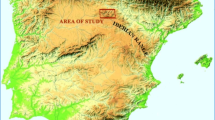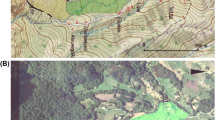Abstract
The paper exposes the results of the study carried out in chain geological context where slopes, because of their lithology and local climate conditions, show to be historically affected by landsliding. The knowledge of the geologic context and of the geomorphological features characterizing an area represents the first step to identify the causes that led to landsliding and to describe its evolutive style. In geological chain areas, the physical properties and rock layering often facilitate slope instability and mass wasting. The study area belongs to the southern slope of the Peloritani Mountains (Sicily, Italy) and lies within the hydrographic basin of the Roccella torrent, an affluent of the Alcantara River. In this area, the slopes that are mainly constituted by flyschoid alternations tectonized during the formation of the Apennine–Maghrebian chain are affected by numerous landslides whose activity permits a detailed study of their evolution. The instability that characterizes the entire basin of the Roccella torrent is well represented by the complex rock slide–earth flow of Roccella Valdemone that has destroyed part of the village of the same name. The paper describes the last landslide event and suggests its previous evolutive history, along with the evolutionary tendency of the slope, through a comparison of several sections at a scale of 1:2,000 that was made on the topographic map carried out in 1970 and successively updated in 1990. Furthermore, the volume of mobilized rock and the erosion rate have been calculated from two different discrete element methods. The results are supported by borehole, seismic, and geoelectrical data confirming the analytical procedure’s validity, applied for complex landslides description, besides the acquisition of useful information for in situ investigation planning in analogous geological frameworks, where instability-induced phenomena are frequent and historical data are fragmentary or missing.










Similar content being viewed by others
References
Ass Reg LL PP (1991) Progetto dei lavori di consolidamento, difesa del suolo, opere in verde a protezione del centro abitato e del quartiere Tintoria
Atzori P, Cirrincione R, Del Mar A, Pezzino A (1994) Structural, metamorphic, and geochronologic features of the Alpine event in the south-eastern sector of the Peloritani mountains (Sicily). Petr Miner 63:113–125
Church HK (1981) Excavation handbook. McGraw-Hill, New York, NY, p 1024
CNR–GNDCI Linea 2 (1994) Progetto AVI-rapporto di Sintesi Sicilia
Douglass J, Dorn RI, Gootee B (2005) A large landslide on the urban fringe of metropolitan Phoenix, Arizona. Geomorphology 65:321–336
Finetti IR, Lentini F, Carbone S, Catalano S, Del Ben A (1996) Il Sistema Appennino Meridionale–Arco Calabro–Sicilia nel Mediterraneo centrale: studio geologico–geofisico. Boll Soc Geol Ital 115:529–559
IAEG Commission on Landslides (1990) Suggested nomenclature for landslides. Bull Int Assoc Eng Geol 41:13–16
Lentini F, Carbone S, Catalano S (1994) Main structural domains of the central Mediterranean region and their Neogene tectonic evolution. Boll Geofis Teor Appl 36(141–144):103–125
Lentini F, Carbone S, Catalano S, Di Stefano A, Gargano C, Romeo M, Strazzulla S, Vinci G (1995a) Sedimentary evolution of basins in mobile belts: examples from the tertiary terrigenous sequences of the Peloritani mountains (NE Sicily). Terra Nova 7:161–170
Lentini F, Carbone S, Catalano S, Grasso M (1995b) Principali lineamenti strutturali della Sicilia nord-orientale. Studi Geol Camerti Volume Speciale 2:319–329
Lentini F, Catalano S, Carbone S (2000) Carta geologica della provincia di Messina scala 1:50.000. Provincia Regionale di Messina–Assessorato Territorio–Servizio geologico, p. 70, Fig. 22
Leoburg T, Fabre R, Clement B, Frappa M (2003) High mountain landslides in the Atlantic Pyrenees: their relationship with the geology and geomorphology. Bull Eng Geol Environ 62:221–229
Ogniben L (1960) Nota illustrativa dello schema geologico della Sicilia nord orientale. Riv Min Sicil 64–65:183–212
Ogniben L (1969) Schema introduttivo alla Geologia del confine calabro–lucano Mem. Soc Geol It 8(4):453–763
Rapisarda F (2003) Modellizzazione di fenomeni di instabilità in aree di catena mediante immagini telerilevate, Università degli Studi di Catania–Dipartimento di Scienze Geologiche tesi Dottorato di Ricerca in Evoluzione geologica di orogeni di tipo mediterraneo, XVI ciclo, p. 109
Varnes DJ (1978) Slope movement types and processes. In: Shuster RL, Krizek RJ (eds) Landslides analysis and control. Washington Transp Res Board Spec Rep 176. Nat Sci Acad:11–33
WP/WLI (1990a) A suggested method for describing the activity of a landslide. Bull Int Assoc Eng Geol 47:53–57
WP/WLI (1990b) A suggested method for reporting a landslide. Bull Int Assoc Eng Geol 41:5–12
Author information
Authors and Affiliations
Corresponding author
Rights and permissions
About this article
Cite this article
Rapisarda, F. Landslide analysis in Apennine chain areas. Landslides 4, 75–83 (2007). https://doi.org/10.1007/s10346-006-0066-8
Received:
Accepted:
Published:
Issue Date:
DOI: https://doi.org/10.1007/s10346-006-0066-8




